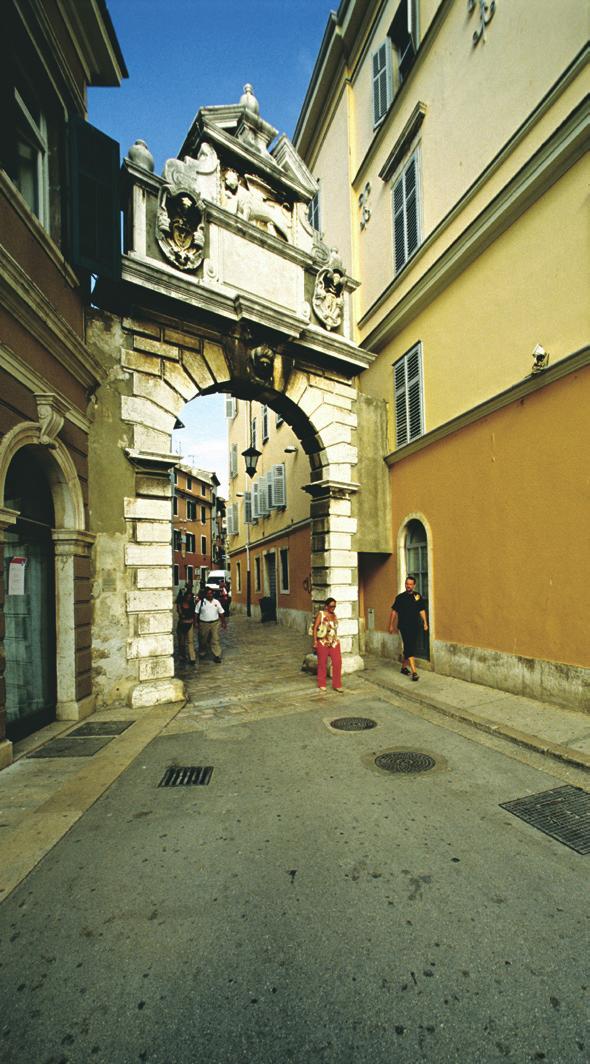This is a SEO version of revitas_urbanaPOVsredista_ITL-ENG. Click here to view full version
« Previous Page Table of Contents Next Page »of St. Mark’s in Venice. In 1758 the copper statue of St. Euphemia which turns like a wind vane, was placed on its spire. Te new church, whose reconstruction began in 1725 due to the dilapidated state of the earlier one, and is together with the Ko-per cathedral the largest sacral Baroque structure in Istria, was fnally consecrated in 1739. On the outside it remained unfnished; in 1780 its side facade was partly covered with stone according to the project of Simone Batistella, whereas the main facade, facing the open sea, was completed only a century later. In time the medieval walls became too tight for the fast growing town within. In 1680 on the site of the Porton della pescheria Balbi’s Arch was erected. From the 17th c. on, the town expands between the two rings of walls on the island and then on the mainland, and fnally in 1763 the channel is flled in. Te overpopu-lated town grows vertically. Te town walls are transformed into housing facilities, whereas new houses are interpolated into open spaces and inner courtyards, thus forming a labyrinth of covered passages and miniature squares. Next to the square opposite the walls, Baroque palaces are erected, such as the Calif Palace, which houses the Rovinj Town Museum. On the opposite side of the channel, at the be-ginning of the 18th c. the Franciscans built a church followed by a monastery. Tis period marks the beginning of urbanization of the mainland part of town, which now spreads to the south along the new Carera Street. Numerous churches are built in the town and its surroundings, such as Our Lady of Health or the votive Church of Our Lady of Mercy with portico.
At the beginning of the 19th c., during the period of Austrian rule, economy pros-pered. In the town and surrounding area a number of plants for processing fsh, production of glass, beverages and cement were built. In the cove Val de laco the Tobacco factory was opened in 1872 for the needs of Austro-Hungarian ofcers. Te old port Andana was reconstructed and modernized with the construction of the Large pier. From the 18th c. a number of small shipyards began to prosper in the southern coves Squeri and Sabionera. For the needs of safe navigation in the Adriatic a lighthouse was built on the small island Sv. Ivan na Pučini in 1853. Owing to its exceptionally pleasant climate Rovinj becomes an attractive health resort. In 1888, a seaside health resort opens on Sv. Pelagija peninsula, north of the town. With the same intention, the wealthy merchant and industrialist Georg Hütterott buys Sv. Andrija Island in 1890, as well as the area south of the town, turning it into the park forest Punta Corrente-Montauro. His ideas set the foun-dations for the development of the most attractive tourist destination in Istria.
visit:
Archaeological park of Monkodonja hill-fort near Veštar.
Crveni Island with Hütterott castle and Pre-Romanesque Church of St. Andrew.
don’t miss:
Large open-air exhibition at the beginning of August in Grisia Street when artists display their works outdoors.
Construction of the traditional fshing boat batana in the eco-museum Te House of Batana (Kuća o batani). Tis is a chance to hear fshermen’s songs bitinade sung in the specifc Rovinj dialect.




72
I CenTRI SToRICI delle CITTà
This is a SEO version of revitas_urbanaPOVsredista_ITL-ENG. Click here to view full version
« Previous Page Table of Contents Next Page »